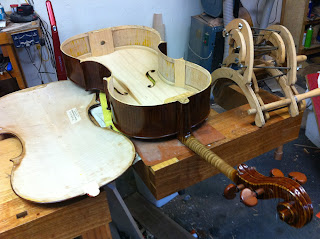The particular tone in the voice on the phone was not recognisable as a specific person , but as a circumstance familiar to me in my work. An 'expensive' instrument with multiple joint failure. The cello neck had broken off, the fingerboard had also come adrift, there was chaos and what could be done?
On examining the instrument I found that the little part of the back plate called the 'button' had also broken at its weakest point, where the purfling cuts across it. Now this little piece is the part of the back that takes a substantial part of the pulling force of the strings, as they try to swing the neck heel upwards, and the fingerboard down. Despite the fact that the neck heel is buried in a sliding single dovetail joint of considerable size, the button is important.
The traditional repair for this failure involves the removal of the back, the re-connection of the button, and the removal of half of its thickness in a graft of new timber on the inside surface of the back. It is an expensive operation, and it costs more than the purchase price of many student cellos. So most cheapies are simply cleaned up, re-glued and sent on their way on the understanding that the repair may last for some years, but it can't be guaranteed. It is only undertaken to keep the cheap instrument working a bit longer, and to save the owner some money and grief.
Further examination of this cello revealed something of our modern dilemma. It is a stylish, impressive looking instrument, made with quite lovely materials, and made accurately in general so that it plays and sounds good.
Look at the spruce top block in the above pic, and in the one below, the lighter patches on the gluing surface of the neck heel. These shots tell us that although the joint pieces are very well made out of good materials, the actual jointing surfaces have made very little contact with their mating surfaces. The neck heel has been held by less than one percent of it's area. These joints were always going to fail. No question. Guaranteed- this instrument was a self-destructing disappointment just waiting for it's moment.
The button is carefully removed from the neck heel and re-attached to the back plate.
About half the thickness of the back is removed to accommodate a graft of suitable timber across the break, shaped in such a way as to resist pulling forces.
The neck was then glued into the renovated top block, and then the instrument is reassembled. Quite a few processes have been omitted here for simplicity.
It really troubles me that so many things are made this way. They are a waste of lovely materials and are always going to create frustration. This wasn't a cheap cello (about $6000), but it and its ilk make it more difficult to sell good ones made by people who delight in trying to do things nicely.
On examining the instrument I found that the little part of the back plate called the 'button' had also broken at its weakest point, where the purfling cuts across it. Now this little piece is the part of the back that takes a substantial part of the pulling force of the strings, as they try to swing the neck heel upwards, and the fingerboard down. Despite the fact that the neck heel is buried in a sliding single dovetail joint of considerable size, the button is important.
The traditional repair for this failure involves the removal of the back, the re-connection of the button, and the removal of half of its thickness in a graft of new timber on the inside surface of the back. It is an expensive operation, and it costs more than the purchase price of many student cellos. So most cheapies are simply cleaned up, re-glued and sent on their way on the understanding that the repair may last for some years, but it can't be guaranteed. It is only undertaken to keep the cheap instrument working a bit longer, and to save the owner some money and grief.
About half the thickness of the back is removed to accommodate a graft of suitable timber across the break, shaped in such a way as to resist pulling forces.
The neck was then glued into the renovated top block, and then the instrument is reassembled. Quite a few processes have been omitted here for simplicity.
It really troubles me that so many things are made this way. They are a waste of lovely materials and are always going to create frustration. This wasn't a cheap cello (about $6000), but it and its ilk make it more difficult to sell good ones made by people who delight in trying to do things nicely.




















































